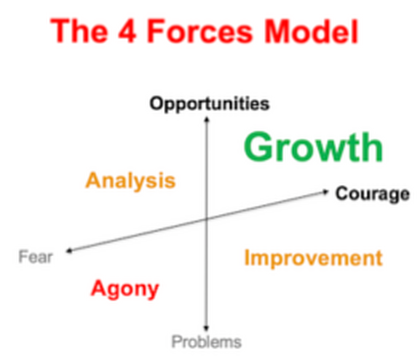Article
Does Your Strategic Plan Really Drive Growth – or Just Improvement?
June 25, 2024
Most companies aspire to have, and put a lot of time and energy into, activities that chart a course for growth.
But, as time goes by, many lose altitude on their growth trajectory.
Everyone is in position. They are fueled up and the instruments in the cockpit seem to be working. And yet, they are going nowhere.
So, what’s the problem?
Chances are the pilot has inadvertently backed off on the throttle.
It’s a pattern we’ve seen in hundreds of companies.
After thousands of strategic planning meetings, I started to notice core patterns: As companies got bigger and more complex, in the day-to-day of getting business done, they either stopped doing some of the things that created their growth, stopped paying attention, or lost touch with what really drove their growth.
It’s a form of forgetting the basics once you think you’ve mastered something.
We’ve all done it.
And when CEOs and executives do it, they inadvertently become disconnected from the growth engine.
Slipping into Improvement Mode
Somehow, people think that when their company becomes bigger and more successful, their job is to administer and improve the business. They work on internal projects and stop leading the charge on projects that have a direct impact on the customer and generating new opportunities: building relationships, enhancing products, exploring and getting new markets, additional resources and partnerships.

When they are no longer in the growth quadrant, that sends a signal to the rest of the business that this improvement mode is ‘business as usual’.
And then growth slows or stops.
Revealing Questions & A Strategic Plan Review
When we work with new organizations, we can get a sense if they are either in improvement mode or growth mode by asking two questions:
- Over the course of an average month, how much time does the CEO spend in internal versus external meetings?
- What percentage of the CEOs time is directly connected to the getting of resources, relationships and opportunities that drive the core growth metric unit of the business next year and the year after versus improving the efficiency or profitability of the current business?
We also look at their strategic plan and goals or objectives for the next three years.
- What percentage of the objectives drive more Xs (the core unit of the business) or get new customers?
- What percentage of the objectives are related to improvement in driving quality, efficiency or profitability?
Ideally,
- A CEO allocates at least 50% of their time to external activities focused on the future growth of the business, and
- At least a third of the three-year objectives, in the strategic plan, are focused on truly driving growth via increasing the Xs (the core unit of the business).
The Challenge
- As a CEO, how much time are you actually spending on growth activities?
- How might you revise your strategic plan/objectives to focus more on real growth (your Xs)?
Other Blogs
- What Would Happen if You Spent Another 10% of Your Time on Growth?
- Getting Bigger & Better with True Growth: More Xs & Profit/X
- The 4 Enemies of Growth
- Do Your Team’s Aspirations Match Your Growth Aspirations?
Older Podcasts
About Lawrence & Co.
Lawrence & Co. is a growth strategy and leadership advisory firm that helps mid-market companies achieve lasting, reliable growth. Our Growth Management System turns 30 years of experience into practical steps that drive clarity, alignment, and performance—so leaders can grow faster, with less friction, and greater confidence.
About Kevin Lawrence
Kevin Lawrence has spent three decades helping companies scale from tens of millions to hundreds of millions in revenue. He works side-by-side with CEOs and leadership teams across North America, the Middle East, Asia, Australia, and Europe, bringing real-world insights from hands-on experience. Kevin is the author of Your Oxygen Mask First, a book of 17 habits to help high-performing leaders grow sustainably while protecting their mental health and resilience. He also contributed to Scaling Up (Rockefeller Habits 2.0). Based in Vancouver, he leads Lawrence & Co, a boutique firm of growth advisors.